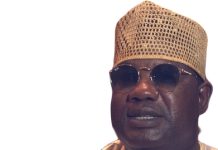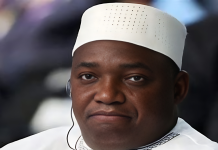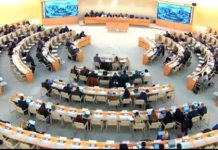By Makutu Manneh
After meeting with President Adama Barrow, Elhadji Lansana Fofana, the High Commissioner of the Organisation for the Development of the Gambia River (OMVG), said measures are being taken to ensure that the National Electricity Company of Guinea respect its commitments to supplying electricity to NAWEC.
After disclosing the incident that happened in Senegal on Thursday, 12 September 2024 when the whole nation faced a general difficulty in accessing electricity supply, Mr. Fofana said, “the interconnection of the power grids of our four member states is almost complete and once done, it will help facilitate the energy being produce in one country to be transported to the other.”
On energy supply, Mr. Fofana said they are pleased to be able to interconnect some of the power grids of member states. He said the Soma and Brikama sub-stations were commissioned by the OMVG to facilitate the transmission of 50 megawatts of energy between Senegal and the Gambia.
As President Barrow is the current chairperson of the Organisation, the OMVG Council of Ministers visited him for a briefing on the state of the organization and its preparedness for the next Council of Heads of States meeting in The Gambia.
The cross-border organization of the West African countries of The Gambia, Senegal, Guinea Conakry, and Guinea-Bissau, have campaigned for the shared use of their natural resources provided by the Gambia River, since the 1980s.
In a similar meeting, the Minister of the Environment, Climate Change and Natural Resources, Rohey John Manjang, briefed President Barrow on the West Africa Coastal Area (WACA) project’s plans and its implementation stage.
Muhammed Lamin Sanyang, the project manager informed the president on the progress made in investment to support infrastructure and livelihood improvement interventions around the Kotu stream.
“Kotu stream is 11.2 km and the catchment area is one thousand, eight hundred and eighty-one hectares. There are over two hundred people living in this densely populated area which when calculated roughly, is about 10 percent of the national population,” he said. Sanyang further said this is a project that has one regional and three national components, adding that the regional component is to effectively coordinate coastal management while the three national components consist of the following three stages: a) the first one is to strengthen policy and institutional capacities around climate change, disaster reduction, pollution prevention and so on; b) component two supports the capacity building of staff of eight government institutions, and the training of their technical staff in matters around climate change, disaster reduction and infrastructures; and the last but not the least is: c) component three has come to strengthen our national, physical and social investment to support infrastructure and livelihood improvement interventions around the kotu stream.



















